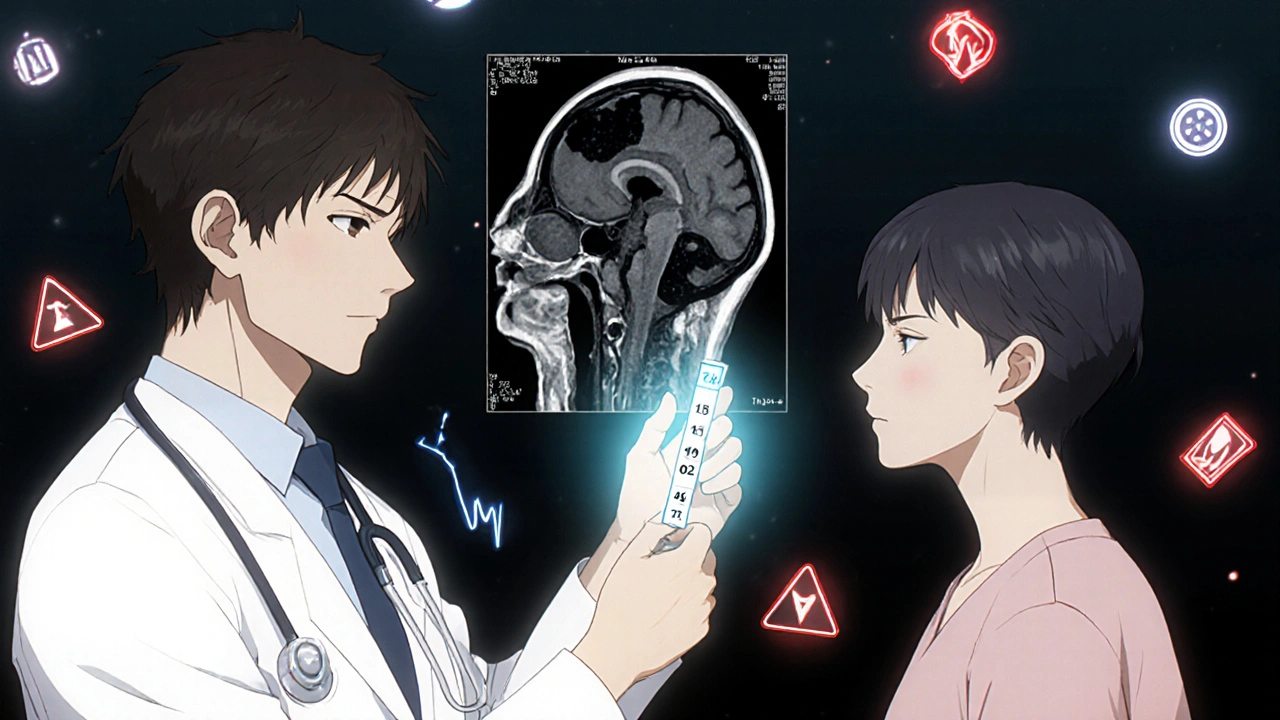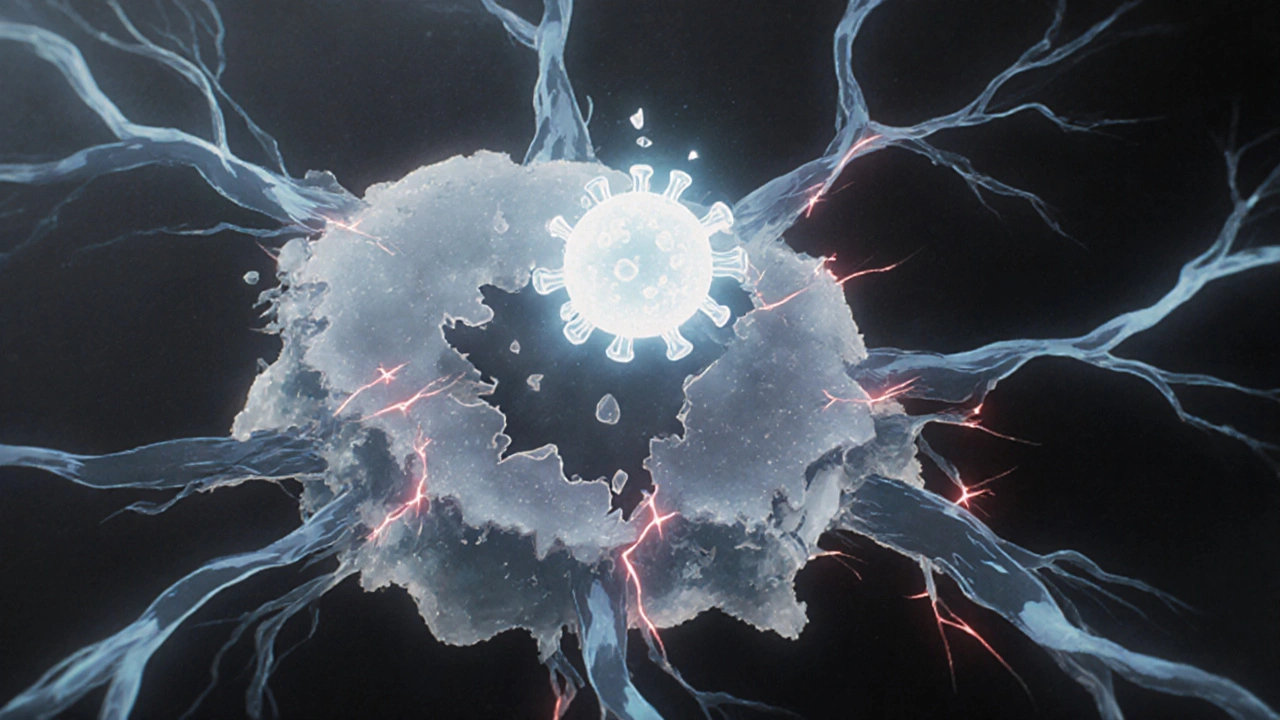PML Risk Calculator
PML Risk Assessment Tool
Estimate your risk of Progressive Multifocal Leukoencephalopathy based on treatment history and monitoring results.
Estimated PML Risk:
What Is Progressive Multifocal Leukoencephalopathy (PML)?
PML is a rare but deadly brain infection caused by the John Cunningham (JC) virus. Most people carry this virus without knowing it-around 50 to 70% of adults have been exposed. In healthy people, the immune system keeps it locked down. But when immunity drops-especially from certain drugs-the virus wakes up, attacks the brain’s white matter, and destroys the protective coating around nerve cells. This leads to progressive damage that can cause weakness, vision loss, speech problems, and loss of coordination. There’s no cure. Survival rates hover between 30% and 50%, and those who survive often face permanent disability.
Why Immunosuppressants Are the Main Culprit
Not all drugs that weaken the immune system carry the same risk. Some, like methotrexate or azathioprine, have very low PML rates. Others, especially monoclonal antibodies, are far more dangerous. The biggest red flag is natalizumab (Tysabri), used for multiple sclerosis and Crohn’s disease. Through 2011, over 82,000 people took it. Of those, 102 developed PML. That’s about 1 in 800. But the risk doesn’t stay the same. It spikes dramatically if you’ve taken other immunosuppressants before, if you’re JC virus antibody positive, or if you’ve been on natalizumab longer than two years.
The Real Risk Factors: It’s Not Just the Drug
Doctors don’t just look at the drug. They look at your history. Three things make PML risk explode:
- You’ve taken another immunosuppressant before-like mitoxantrone, azathioprine, or methotrexate. This alone bumps your risk 2.5 times.
- Your blood test shows you’ve been exposed to JC virus (JC antibody positive). About 60% of people are positive, but if you’re on natalizumab and positive, you’re in the danger zone.
- You’ve been on the drug longer than 24 months. The longer you’re exposed, the higher the chance the virus breaks free.
Even then, it’s not guaranteed. Some people on natalizumab for five years never get PML. Others develop it after just 18 months. That’s why testing and monitoring aren’t optional-they’re life-saving.
How Risk Is Measured: The JC Antibody Index
The JC virus antibody test isn’t just yes or no. It gives you a number-the index. A low index (under 0.9) means your risk after four years of natalizumab is about 0.09%. That’s rare. But if your index is above 1.5, your risk jumps to nearly 11%. That’s over 100 times higher. This number helps doctors decide whether to keep you on the drug or switch you to something safer. Some clinics test this every six months. If your index climbs, they may pull you off natalizumab before symptoms start.

Other High-Risk Drugs Beyond Natalizumab
Natalizumab gets the most attention, but it’s not the only one. Fingolimod (Gilenya) has about 0.4 cases per 1,000 patient-years. Dimethyl fumarate (Tecfidera) is lower, at 0.2. Rituximab (Rituxan), used for lymphoma and autoimmune diseases, carries a higher risk-0.8 cases per 1,000. Even ibrutinib (Imbruvica), a cancer drug, has shown PML cases in clinical trials. The common thread? These drugs blunt T-cell immunity, the exact part of your immune system that keeps JC virus asleep.
Why Early Detection Is Everything
PML symptoms are sneaky. They mimic MS relapses: blurry vision, trouble speaking, one-sided weakness, memory slips. That’s why 37% of cases are misdiagnosed at first. The only way to catch it early is through regular brain MRIs-every 3 to 6 months if you’re on a high-risk drug. Special MRI sequences can spot PML lesions before you even feel symptoms. One Reddit user, u/MSWarrior2023, found early PML lesions on an MRI despite a negative JC test. That’s the 2-3% false-negative rate in action. Had they waited for symptoms, it might have been too late.
What Happens When PML Is Caught Early
Stopping the drug is step one. That’s it. No magic pill. But stopping natalizumab can trigger something even scarier: immune reconstitution inflammatory syndrome (IRIS). In 50-60% of cases, your immune system wakes up too fast and starts attacking your brain, causing swelling and inflammation. It’s dangerous, but treatable. High-dose steroids like methylprednisolone are often used to calm the reaction. One patient, u/NatalizumabSurvivor, stopped natalizumab at the first sign of PML, went through six months of IRIS treatment, and regained 90% of motor function. Early action saved their life.

What Doctors Are Doing Differently Now
Since 2010, the FDA and EMA have forced drug makers to track PML risk closely. Before prescribing natalizumab, doctors must confirm your JC status and ask: “Have you ever taken another immunosuppressant?” They also need special training to get certified. Academic centers now have strict protocols: MRI every 6 months, JC testing every 6 months, and a clear plan to switch drugs if risk climbs. But community clinics lag behind-only 67% have formal PML monitoring, compared to 92% at major hospitals.
What Patients Are Saying
On MS forums, fear of PML is real. In a 2024 survey of 214 patients on natalizumab, 78% said they felt extreme anxiety about PML. Over half said they’d quit the drug after two years-even if it was controlling their MS. That’s how powerful the fear is. Some switch to newer drugs like ocrelizumab, which has no confirmed PML cases. Others stay on, trusting their monitoring. One patient wrote: “I’d rather live with a little MS than risk brain damage from PML.” That’s the trade-off many face.
What’s Coming Next
Hope is on the horizon. A new T-cell therapy called DIAVIS showed a 68% drop in PML deaths in a small 2024 trial. Immune checkpoint drugs like pembrolizumab are being tested to help the body fight the virus. The Cleveland Clinic is running a trial using maraviroc, an HIV drug, to block JC virus from entering brain cells. If it works, it could become a preventive tool. By 2030, experts predict PML rates on natalizumab could fall to 0.5 cases per 1,000 patient-years-low enough that it might be reconsidered as a first-line option for some.
What You Should Do If You’re on Immunosuppressants
If you’re taking any of these drugs, here’s what to do:
- Know your JC virus antibody status. Get tested before starting and repeat every 6 months.
- Ask your doctor: “Have I ever taken another immunosuppressant?” That history matters.
- Get brain MRIs on schedule-even if you feel fine.
- Report any new symptoms immediately: blurry vision, slurred speech, weakness on one side.
- Don’t ignore anxiety. Talk to your neurologist about switching drugs if the fear outweighs the benefit.
PML is rare. But when it hits, it hits hard. The difference between life and death often comes down to timing. Stay informed. Stay monitored. Don’t wait for symptoms to start.


Graham Holborn
Hi, I'm Caspian Osterholm, a pharmaceutical expert with a passion for writing about medication and diseases. Through years of experience in the industry, I've developed a comprehensive understanding of various medications and their impact on health. I enjoy researching and sharing my knowledge with others, aiming to inform and educate people on the importance of pharmaceuticals in managing and treating different health conditions. My ultimate goal is to help people make informed decisions about their health and well-being.